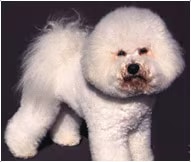About
The length of the bichon is somewhat longer than height. The plumed tail is carried over the back. Bichons have heads that are well-proportioned to their bodies, and drop ears. Their nose is pronounced and black.Both males and females of the breed stand just under 30cm and weigh from 3-6kgs.|
Personality
The bichon frise is considered a great all-around pet that is a playful yet gentle dog. Bichons get along well with other pets. They are generally considered very good with kids. In one survey, they ranked high on snapping at children, but caution is in order anytime dogs and small children are together. In the same survey, they were found easy to house-train and train but some owners disagree with the easy house-training label.
What to Expect
Bichons are active dogs, but because they are small, they don't need too much room to romp and are suitable for apartment living. Bichons are not known for barking, which is a real plus for city dwellers, but don't count on them to guard your home.They do require considerable time for coat care. They need grooming, bathing and trimming on a regular basis. Bichons are one of the few breeds recommended for people with allergies who want a dog. Be aware that even though some people with mild allergies may have fewer allergy problems with a bichon compared with other dogs, there are no guarantees. Consult your allergist and spend considerable time around adult bichons before deciding to live with one.
History
The bichon frise (pronounced bee-SHON free-ZAY) is thought to be a descendant of the water spaniel and was known in the Mediterranean area as far back as the Middle Ages. Some historians believe the breed actually originated in the Canary Islands and was brought to Europe by sailors. Bichons have long been recognised as good companion dogs, mostly because of their cheerful, even temperaments. They were quite popular with European nobility, in the English court during Henry II's reign, and were even included in paintings by Goya.By the 19th century, their popularity had declined. They were street dogs and some were used in circus troupes. Their popularity rose again after World War I. The breed was first brought to the United States in 1956 by a French family named Picault. The breed was recognised in 1973 by the American Kennel Club as a non-sporting dog.In recent years, bichons have become more popular as people learn about the desirable traits of the breed.
Adopt a pet. Change a life.
Are you prepared to adopt a pet? Use these tools to make sure you are ready for the commitment.
Adopt a pet. Change a life.
Are you prepared to adopt a pet? Use these tools to make sure you are ready for the commitment.






















